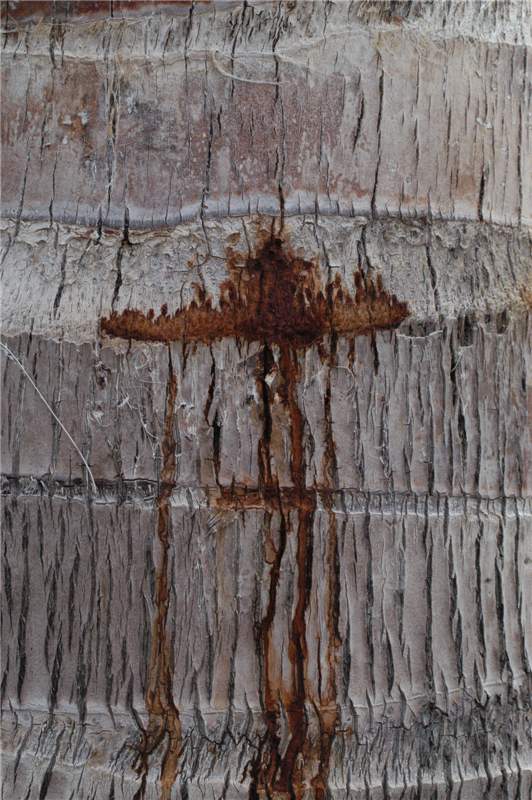Thielaviopsis Trunk Rot
|
Figure 2. Syagrus romanzoffiana trunk collapse due to Thielaviopsis trunk rot. Only a few young green leaves remain. Note the "stem bleeding" or oozing of plant liquid down the trunk from the point of collapse.
|
|
Figure 1. Trunk collapse of a Washingtonia robusta due to Thielaviopsis trunk rot. Note that most of the canopy was still green. Photo by F. W. Howard, University of Florida.
|
|
Figure 4. Only one side of this trunk has significant rot due to Thielaviopsis paradoxa. The fungus rots the trunk tissue from the outside to the inside. Photo by M. L. Elliott.
|
|
Figure 3. The three Cocos nucifera on the left have died from Thielaviopsis trunk rot. The palm in the foreground exhibits trunk collapse. Photo by M. L. Elliott.
|
|
Figure 6. An example of "stem bleeding" on a Cocos nucifera trunk. The top of the blackened area was very soft and could be easily pushed in with the fingers. Photo by M. L. Elliott.
|
|
Figure 5. The canopy of Cocos nucifera in the center is wilted and necrotic due to a trunk infection by Thielaviopsis paradoxa. The infection site was just below the oldest leaf base. Photo by M. L. Elliott.
|
|
Figure 7. The trunk of this Cocos nucifera was just beginning to exhibit "stem bleeding", but the large rusty-brown area at the top was already soft. Photo by M. L. Elliott.
|
Other common names
stem bleeding; sudden crowncrown:
see canopy
or canopycanopy:
the cluster of leaves borne at the tip of the stem
drop
Scientific name of pathogen
Thielaviopsis paradoxa is the pathogen most commonly associated with Thielaviopsis trunk rot. A second pathogen associated with this disease is Thielaviopsis radicicola. Both pathogens belong to Kingdom Fungi, Phylum Ascomycota.
Hosts
All palm species are considered potential hosts of Thielaviopsis paradoxa. The only known hosts of Thielaviopis radicicola are Cocos nucifera and Phoenix dactylifera.
Distribution
Thielaviopsis paradoxa has a worldwide distribution. Thielaviopis radicicola appears to be limited to Kuwait, Mexico, South Africa and the USA (California only).
Symptoms/signs
Thielaviopsis paradoxa degrades (rots) non-lignified or minimally lignified plant tissue. Thielaviopsis trunk rot is most often observed on mature palms with considerable trunk height. In the landscape, the trunk rot most often occurs in the upper half of the trunk or just below the apical meristemmeristem:
the growing region of a plant, a special area of undifferentiated cells wherein new cells and organs are developed
(bud) where there is less lignified trunk tissue. In palms with shorter trunks, which have less lignified tissue overall, the disease may occur anywhere on the trunk.
Unfortunately, there often are no visible indications that a palm has Thielaviopsis trunk rot until either the trunk collapses on itself (Figs. 1-3) or the canopycanopy:
the cluster of leaves borne at the tip of the stem
suddenly falls off the trunk. The canopycanopy:
the cluster of leaves borne at the tip of the stem
may appear relatively normal and healthy, as does the trunk externally. When the trunk collapse or canopycanopy:
the cluster of leaves borne at the tip of the stem
drop is observed, it means the fungus has rotted the trunk tissue to such an extent that the trunk can no longer structurally support itself. Examination of a cross-section through the diseased portion of the trunk will illustrate that the rot is located only on one side of the trunk (Fig. 4).
Visible symptoms that may be observed include wilting and necrosisnecrosis:
dead tissue, usually desiccated and brown to gray in color
of leaves (Fig. 5), beginning with the lowest leaves in the canopycanopy:
the cluster of leaves borne at the tip of the stem
. Darkened, very soft areas on the trunk may also be observed (Fig. 6), either associated with leaf wilt and necrosisnecrosis:
dead tissue, usually desiccated and brown to gray in color
or as an independent symptom. Push in with your fingers (or the blunt end of a small tool) on the suspected soft spot and then compare to other areas of the trunk (opposite side from soft area and further down on the trunk). If a trunk rot is present, you can easily push into the trunk an inch or more. In some cases, "stem bleeding" will occur, an oozing of plant liquid down the trunk that originates from the infection point (Fig. 7). Observation of these trunk symptoms is most likely on palms with smooth trunks, such as Cocos nucifera.
May be confused with
Fungal diseases: Ganoderma butt rot causes an internal rot of highly lignified tissue in the bottom 3 to 5 feet of the trunk. Ganoderma butt rot normally rots the trunk from the inside to the outside, whereas Thielaviopsis trunk rot destroys the trunk tissue from the outside to the inside.
Disorders: Lightning, bird damage, nail holes, and so on may cause physical damage to the trunk and cause the trunk to "bleed". However, the initiation point of the sap oozing due to these disorders will not be soft and rotted. Lightning may cause the quick collapse of the canopycanopy:
the cluster of leaves borne at the tip of the stem
or dislodge the canopycanopy:
the cluster of leaves borne at the tip of the stem
completely. Severe drought stress will cause wilt symptoms.




